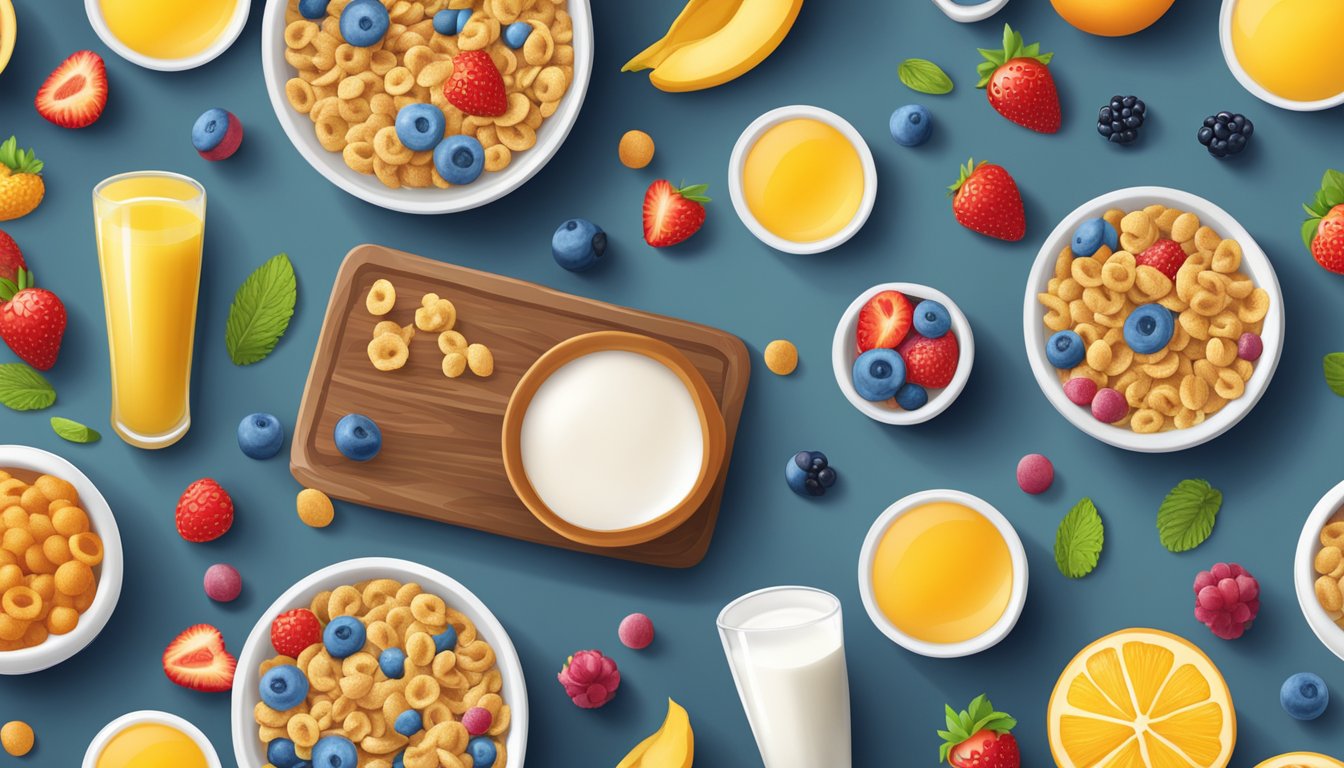Breakfast cereals have been a staple morning meal for decades. Marketed as convenient and nutritious, these colorful boxes line grocery store shelves, promising health benefits and energy to start the day. But are breakfast cereals truly as healthy as they claim to be?
The nutritional value of breakfast cereals varies widely, with some offering significant health benefits while others are little more than sugary treats. Healthier options tend to be high in fiber, low in added sugars, and fortified with essential vitamins and minerals. These cereals can provide a quick source of complex carbohydrates, protein, and important nutrients to fuel the body.
Many traditional cereals, however, contain excessive amounts of sugar and refined carbohydrates. These less nutritious options may lead to blood sugar spikes and crashes, potentially contributing to weight gain and other health issues if consumed regularly. Consumers should carefully read nutrition labels and ingredient lists to make informed choices about which cereals best align with their dietary needs and health goals.
Understanding Nutrition in Breakfast Cereals
Breakfast cereals offer a range of nutritional components that can impact overall health. Examining labels and ingredients is key to making informed choices about cereal consumption.
Nutritional Components of Cereals
Breakfast cereals typically contain a mix of carbohydrates, fiber, proteins, vitamins, and minerals. Many are fortified with essential nutrients like iron, B vitamins, and vitamin D. Whole grain cereals provide more fiber and nutrients compared to refined grain varieties.
Protein content varies widely between cereals, with some offering significant amounts while others contain minimal protein. Fiber is another crucial component, aiding digestion and promoting satiety.
Many cereals contain added sugars, which can contribute to excessive calorie intake if consumed in large amounts. Some cereals also include artificial colors, flavors, or preservatives.
Reading the Nutrition Label
Nutrition labels provide valuable information about cereal content. Key areas to focus on include:
- Serving size
- Calories per serving
- Total carbohydrates
- Dietary fiber
- Protein
- Added sugars
- Vitamins and minerals
Compare these values to daily recommended intakes. Look for cereals with higher fiber and protein content, and lower added sugar levels.
Check the ingredients list. Ingredients are listed in descending order by weight. Whole grains should ideally appear first.
Importance of Whole Grains
Whole grain cereals offer significant nutritional benefits. They contain all parts of the grain kernel: bran, germ, and endosperm. This provides more nutrients and fiber compared to refined grains.
Whole grains in cereals can help:
- Reduce risk of heart disease
- Lower cholesterol levels
- Improve digestive health
- Aid in weight management
Look for terms like “whole wheat,” “whole oats,” or “whole grain” as the first ingredient. Be cautious of misleading terms like “made with whole grains,” which may indicate only a small amount is present.
Whole grain cereals often have a nuttier flavor and denser texture than refined grain varieties. They can be an excellent source of complex carbohydrates for sustained energy throughout the morning.
Health Benefits of Quality Cereals
Nutritious breakfast cereals can provide essential nutrients and support overall wellbeing when chosen wisely. Quality cereals offer several health advantages that contribute to a balanced diet.
Fiber-Rich Cereals and Digestive Health
Cereals high in fiber promote digestive health and regularity. Whole grain cereals typically contain both soluble and insoluble fiber, which aid in maintaining a healthy gut microbiome.
Soluble fiber helps lower cholesterol levels and regulate blood sugar. Insoluble fiber adds bulk to stool, preventing constipation and supporting bowel movements.
A fiber-rich breakfast can help you feel full longer, potentially reducing overeating later in the day. Aim for cereals with at least 3 grams of fiber per serving.
Some cereals contain added prebiotics, which further support beneficial gut bacteria growth.
Protein in Cereal and Muscle Maintenance
Many quality cereals now include protein sources like nuts, seeds, or added milk proteins. Protein is crucial for muscle maintenance and repair.
A protein-rich breakfast can help stabilize blood sugar levels and reduce cravings throughout the day. Look for cereals with 5 grams or more of protein per serving.
Some cereals use plant-based proteins from sources like pea protein or soy, making them suitable for vegetarian and vegan diets.
Protein-fortified cereals can be especially beneficial for athletes, older adults, and those looking to increase their protein intake.
Cereals High in Vitamins and Minerals
Quality cereals are often fortified with essential vitamins and minerals. These nutrients support various bodily functions and help prevent deficiencies.
Iron-fortified cereals can be particularly beneficial for women and vegetarians who may be at risk of iron deficiency. Calcium and vitamin D fortification supports bone health.
B vitamins, commonly added to cereals, play crucial roles in energy metabolism and nervous system function. Some cereals contain antioxidants like vitamin E, which helps protect cells from damage.
Zinc, often present in fortified cereals, supports immune function and wound healing. Magnesium, found in whole grain cereals, is important for muscle and nerve function.
Negative Aspects of Some Breakfast Cereals
Many breakfast cereals contain high amounts of added sugars, refined grains, and sodium. These ingredients can contribute to various health concerns when consumed regularly.
Consequences of Added Sugars
Excessive sugar intake from breakfast cereals can lead to several health issues. Many popular cereals contain more than 40% sugar by weight, with some reaching up to 56%. This high sugar content can cause rapid spikes in blood glucose levels, followed by crashes that may trigger cravings for more sugary foods.
Regular consumption of sugary cereals can contribute to:
- Weight gain
- Increased risk of type 2 diabetes
- Dental cavities
- Mood swings and irritability
Children are particularly vulnerable to the effects of high-sugar cereals, as they are often the target audience for these products.
The Impact of Refined Grains
Many breakfast cereals are made with refined grains, which have been stripped of their bran and germ layers. This process removes essential nutrients and fiber, leaving mostly empty calories.
Refined grains in cereals can:
- Raise blood sugar levels quickly
- Contribute to a higher glycemic index
- Provide less satiety compared to whole grains
- Potentially increase the risk of obesity and metabolic syndrome
Consuming cereals made with refined grains may leave individuals feeling hungry soon after eating, leading to overeating later in the day.
High Sodium and Cardiovascular Risk
Some breakfast cereals contain significant amounts of sodium, which can contribute to elevated blood pressure and increased cardiovascular risk. High sodium intake is linked to:
- Hypertension
- Increased risk of heart disease and stroke
- Water retention and bloating
The American Heart Association recommends limiting daily sodium intake to 2,300 mg or less. Some cereals can contribute a substantial portion of this limit in a single serving, especially when combined with other high-sodium foods throughout the day.
Individuals with existing cardiovascular conditions or those at risk should be particularly mindful of the sodium content in their breakfast cereals.
Making Healthier Breakfast Choices
Selecting nutritious cereals and incorporating them into a balanced diet can contribute to a healthier breakfast routine. Proper portion control is also crucial for maintaining a wholesome morning meal.
Selecting Cereals with Healthy Ingredients
When choosing breakfast cereals, focus on whole grain options. These provide more fiber and nutrients than refined grains. Look for cereals with at least 3 grams of fiber per serving.
Check the ingredients list for simple, recognizable items. Avoid cereals with excessive added sugars or artificial additives.
Organic cereals can be a good choice for those wanting to avoid synthetic pesticides and fertilizers. Gluten-free options are available for individuals with celiac disease or gluten sensitivity.
Some cereals are fortified with vitamins and minerals, which can boost their nutritional value.
Incorporating Cereals into a Balanced Diet
Pair cereal with protein-rich foods like Greek yogurt or milk to create a more satisfying meal. This combination helps stabilize blood sugar levels and provides longer-lasting energy.
Add fresh fruits to increase vitamin and antioxidant content. Berries, sliced bananas, or diced apples are excellent choices.
Consider using cereal as a topping for smoothie bowls or yogurt parfaits for variety. This can help maintain interest in healthier breakfast options.
For those focused on weight management, cereals can be part of a balanced diet when consumed in appropriate portions and combined with other nutrient-dense foods.
Understanding Serving Sizes
Pay close attention to serving sizes listed on cereal boxes. Many people unknowingly consume multiple servings in one sitting.
Use measuring cups to portion out cereal accurately. This helps control calorie intake and prevents overeating.
A typical serving size for most cereals ranges from 30 to 45 grams, or about 3/4 to 1 cup. Adjust portions based on individual nutritional needs and activity levels.
Be aware that larger bowls can lead to larger portions. Consider using smaller dishes to help with portion control.
Specialty Cereals and Diet Considerations

The cereal market has expanded to cater to diverse dietary needs and health preferences. Manufacturers now offer a wide range of specialty cereals designed to accommodate various nutritional requirements and lifestyle choices.
Cereals for Restricted Diets
Gluten-free cereals have become increasingly common, providing options for those with celiac disease or gluten sensitivity. These cereals often use alternative grains like rice, quinoa, or corn. Keto-friendly cereals are low in carbohydrates and high in fats, typically containing nuts, seeds, and coconut.
Vegan cereals exclude animal-derived ingredients, appealing to plant-based eaters. Many are fortified with B12 and other nutrients commonly found in animal products. Organic cereals use ingredients grown without synthetic pesticides or fertilizers, appealing to environmentally conscious consumers.
For those watching their fat intake, low-fat milk alternatives like almond or oat milk can be paired with whole grain cereals.
Innovations in Healthy Cereals
Recent innovations in cereal production focus on boosting nutritional value while maintaining taste. Some cereals now incorporate probiotics to support gut health. Others add plant-based proteins from sources like pea or hemp to increase satiety.
Manufacturers are reducing added sugars and replacing them with natural sweeteners like monk fruit or stevia. Fiber-rich ingredients such as chicory root or psyllium husk are being added to improve digestive health.
Some brands are creating functional cereals with specific health benefits, such as improved heart health or enhanced cognitive function. These often include ingredients like omega-3 fatty acids or antioxidant-rich berries.
A Guide to Popular Breakfast Cereal Brands
Breakfast cereal brands offer a wide range of options, from nutritious whole grain varieties to indulgent sugary choices. Many popular cereals fall into two main categories: those focused on health and fiber, and those marketed for their sweet flavors.
Whole Grain and Fiber-Rich Brands
Cheerios stands out as a widely recognized whole grain cereal. Made from oats, it provides a good source of fiber and is often recommended by dietitians. Grape Nuts, another fiber-rich option, offers a crunchy texture and nutty flavor.
Nature’s Path Organic produces several healthy cereals, including Heritage Flakes. This brand focuses on organic ingredients and whole grains. Ezekiel 4:9 Organic Sprouted Whole Grain Cereal uses sprouted grains for enhanced nutrient absorption.
Muesli and granola variants often contain a mix of oats, nuts, and dried fruits. These cereals typically offer higher protein and healthy fat content compared to many conventional options.
The Surge of Sugary Cereal Brands
Cinnamon Toast Crunch and Frosted Flakes represent popular sugary cereals. These brands often feature mascots and colorful packaging to appeal to children. Lucky Charms combines sweetened corn pieces with marshmallows, creating a unique texture mix.
Froot Loops uses artificial colors and flavors to produce its distinctive appearance. Honey Nut Cheerios adds sweetness to the original Cheerios formula with honey and almond flavoring.
Raisin Bran attempts to balance sweetness with nutrition by adding raisins to bran flakes. While it contains more sugar than plain bran cereals, it still provides fiber.
Unique Breakfast Cereal Alternatives
Breakfast cereal alternatives offer nutritious and delicious options to start your day. These choices provide essential nutrients, fiber, and protein to fuel your morning.
Healthy Homemade Cereal Options
Create your own cereal mix using whole grain puffs, nuts, and dried fruit. Combine 1 cup of whole grain puffs with 1/4 cup of chopped nuts and 2 tablespoons of dried fruit. Add a sprinkle of chia or flax seeds for extra nutrition.
Homemade granola is another tasty option. Mix oats, nuts, and seeds with a small amount of honey and bake until golden. Serve with milk or yogurt for a satisfying breakfast.
For a warm option, try porridge made from whole grain oats. Cook oats with milk or water and top with fresh fruit, a dollop of Greek yogurt, and a drizzle of honey.
Non-Cereal Healthy Breakfasts
Overnight oats offer a convenient, no-cook breakfast. Combine equal parts oats and milk in a jar, add chia seeds and your favorite toppings, then refrigerate overnight.
Greek yogurt parfaits provide a protein-rich start to the day. Layer Greek yogurt with fresh berries, chopped nuts, and a sprinkle of hemp seeds.
Whole grain toast with toppings is a quick and easy option. Spread peanut butter on toast and top with sliced banana or berries for a balanced meal.
For a savory choice, try avocado toast topped with a poached egg. This combination provides healthy fats and protein to keep you full until lunch.




